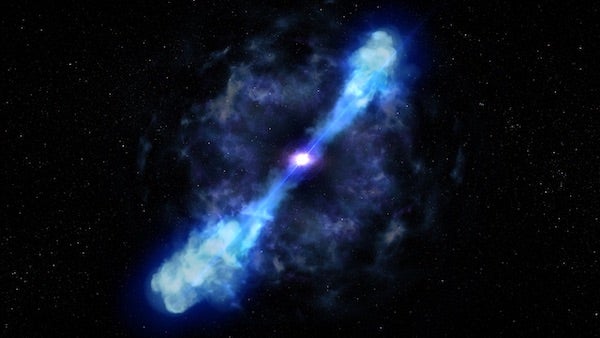When stars collide, the result is often explosive. That’s especially true when those objects are a pair of super dense stellar remnants known as neutron stars. The fireworks show, called a kilonova, unleashes more energy than the Sun will produce during its 10-billion-year lifetime.
And wouldn’t you know it, the light from one such collision reached Earth early this year on May 22. After traveling nearly 5.5 billion light-years, the brilliant flash was first detected by NASA’s Gehrels Swift Observatory. Then, telescopes across the world quickly turned their eyes to the aftermath of the explosion.
As the most luminous kilonova event on record, the find was already groundbreaking, resulting in some of the most detailed observations to date. But data from the Hubble Space Telescope took that even further. When Hubble observed it in infrared, the event was 10 times brighter than anticipated, suggesting something unexpected resulted from the merger.
Prior to the Hubble observations, scientists believed that the most likely outcome of two neutron stars merging was a black hole. But these findings, detailed in a paper to be published in The Astrophysical Journal, tell a different story.
According to study author Wen-fei Fong, it’s possible that a heavier neutron star was born of the collision and managed to survive. “Instead of collapsing into a black hole,” said Fong in a press release. “It became a magnetar: A rapidly spinning neutron star that has large magnetic fields, dumping energy into its surrounding environment and creating the very bright glow that we see.”
This is the first time researchers have seen evidence of merging neutron stars giving birth to a magnetic monster.
NASA, ESA, and D. Player (STScI)
Neutron stars, kilonovas, and magnetars, oh my!
Space is filled with extremes — and neutron stars are just one example.
These exotic stars are the dense remnants of once massive supergiants. At the end of their lives, these massive stars — ranging from 10 to 25 times the mass of the Sun — explode in a violent firework show, called a supernova, leaving a neutron star behind. Neutron stars cram nearly twice the mass of the Sun into a space about the size of Chicago. A single tablespoon of neutron star, for example, would weigh 1 billion tons (900 billion kilograms) — roughly the same as Mount Everest.
And when two neutron stars merge, the resulting kilonova explosion glows 100 million times brighter than the Sun. Kilonovae shine as a result of the radioactive decay of heavy elements thrown from the merger, which produces elements like gold and platinum. These events last less than two seconds and are known as short gamma-ray bursts.
When light from GRB 200522A reached Earth, the Hubble Space Telescope observed the event across the entire electromagnetic spectrum, finding the infrared emissions to be 10 times greater then predicted. The most likely explanation: the remnant of the collision was feeding energy into the emission.
Before this, scientists believed that a neutron star merger formed an unstable, heavy neutron star that only lasted for a handful of milliseconds before collapsing into a black hole. But a black hole wouldn’t explain the extra energy Hubble saw during this kilonova.
A magnetar, on the other hand, would provide the perfect storm.
“You basically have these magnetic field lines that are anchored to the star that are whipping around at about 1,000 times a second, and this produces a magnetized wind,” said the study’s co-author, Tanmoy Laskar. “These spinning field lines extract the rotational energy of the neutron star formed in the merger, and deposit that energy into the ejecta from the blast, causing the material to glow even brighter.”
Typically, magnetars are born like their less magnetic cousins: From the deaths of massive stars. However, these findings suggest that at least a small portion of them form during neutron star mergers, something never seen before.
In order to know for certain, scientists will have to keep their eyes trained on this area of the sky. If a magnetar really is lighting it up, then, within a few years, the ejected material from the burst will begin appearing in radio wavelengths.
“Now that we have one very bright candidate kilonova,” said Jillian Rastinejad, paper co-author. “I’m excited for the new surprises that short gamma-ray bursts and neutron star mergers have in store for us in the future.”










